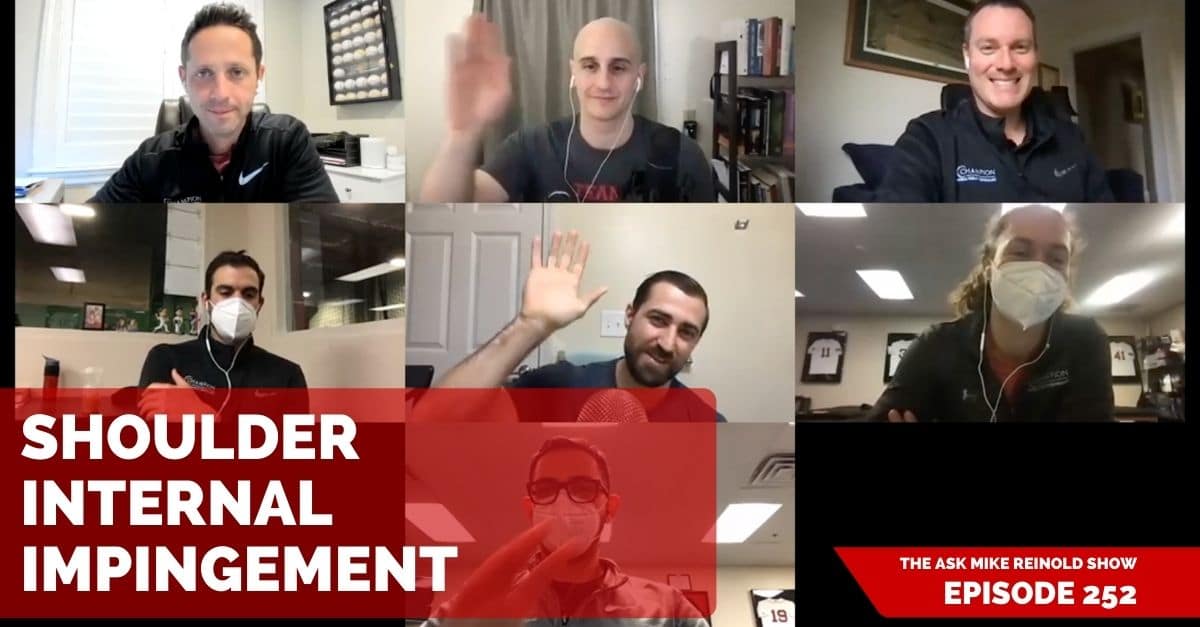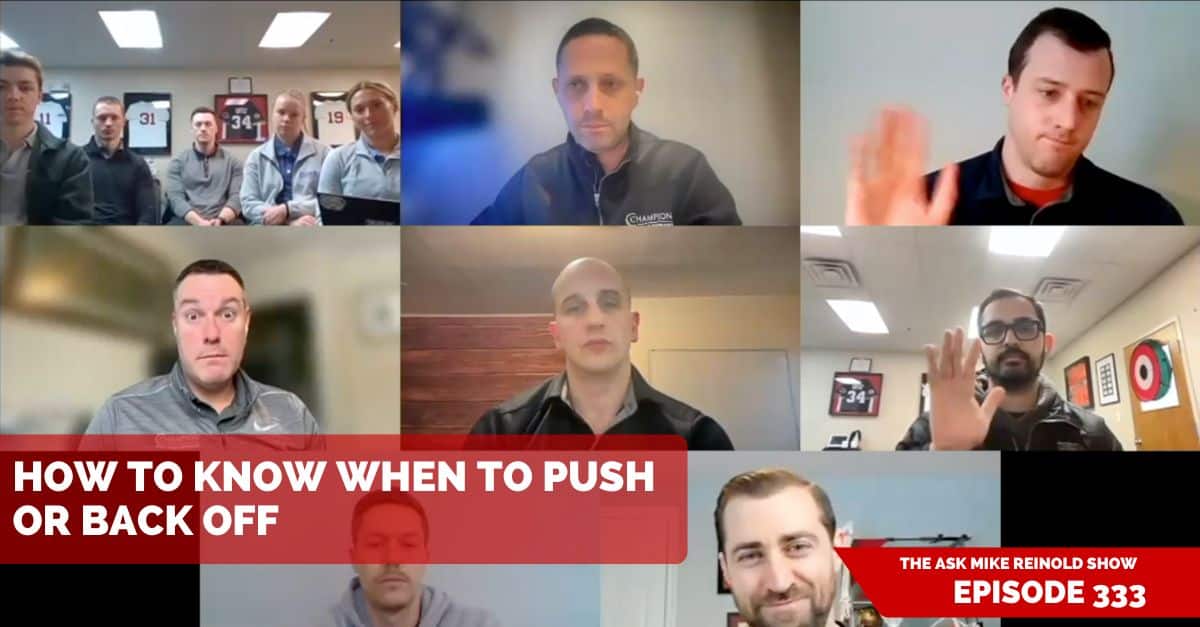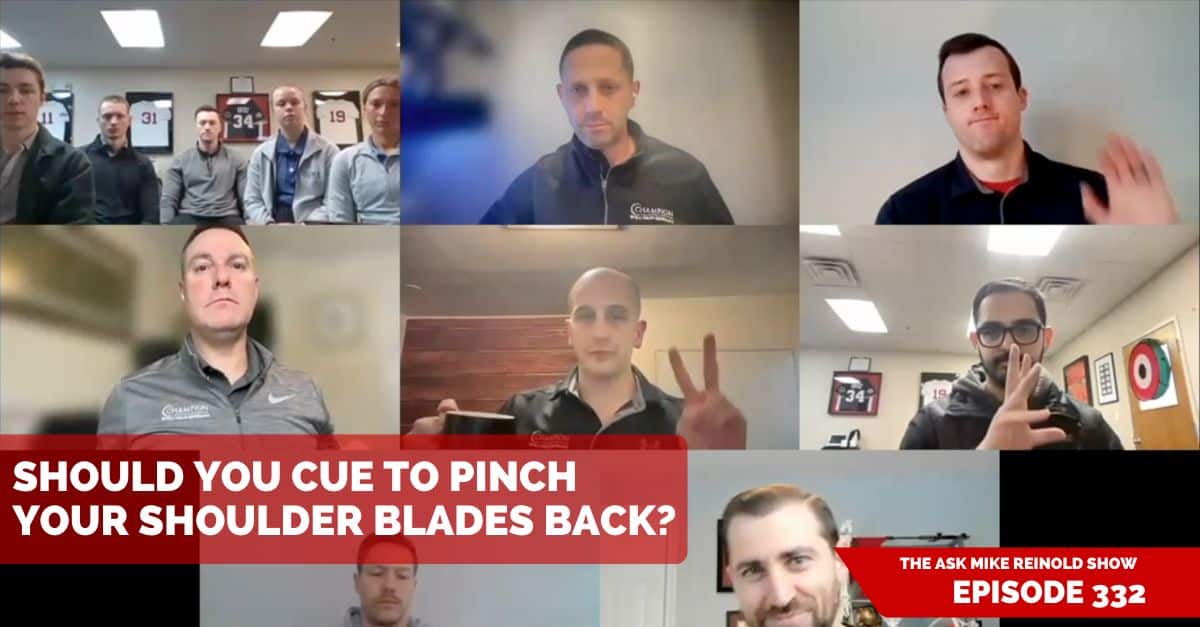One of the most common injuries we see in baseball players is shoulder internal impingement.
Internal impingement is a very specific pathology. The key to treating it is to understand it first.
To view more episodes, subscribe, and ask your questions, go to mikereinold.com/askmikereinold.
#AskMikeReinold Episode 252: Shoulder Internal Impingement
Listen and Subscribe to Podcast
You can use the player below to listen to the podcast or subscribe. If you are enjoying the podcast, PLEASE click here to leave us a review in iTunes, it will really mean a lot to us. THANKS!
Show Notes
- How to Treat Internal Impingement of the Shoulder
- Internal Impingement – What it is and How to Diagnose
- Shoulder Impingement – 3 Keys to Assessment and Treatment
Transcript
Mike Reinold:
Bill from Boston asks, “What considerations, exercises and modalities would you use when addressing internal shoulder impingement in baseball athletes?” And it’s funny when I’m reading that question now, that’s essentially saying what do you do with internal impingement? You know, very generalized non-specific. So that’s actually a gigantic question, Bill. So let me help guide this a little bit. Let’s talk about breaking this down. Quickly, briefly who wants to start, maybe Leonard, would you like to start on saying what is internal impingement? We’ll chunk out these answers a little bit to help Bill, but before we can figure out what you have to do to treat internal impingement, I think we have to understand what is internal impingement and is it different from shoulder impingement? So Len, do you want to knock that one out?
Lenny Macrina:
Yeah. So, internal impingement is also known as posterior impingement. So it’s impingement of the rotator cuff in the back of the shoulder versus the top of the shoulder. So it’s not subacromial impingement.
Mike Reinold:
Is that true? I don’t think I’ve ever called it posterior impingement. I mean, I trust you. I believe you.
Lenny Macrina:
Yeah. So if you think of it that way, it’s the infraspinatus gets pinched on the back of the shoulder at the glenoid and then you have to figure out why. So it’s an overuse injury to the back of the shoulder and now we figured that out, hopefully, with our exam or an MRI, and now we get to figure out why this is happening. And that’s where it gets really interesting. Is it a mobility thing where they have too much laxity, is it an overuse thing? Is it a mechanical thing? So many different reasons why, but you have to make sure it’s not a posterior labral tear or some kind of a cyst, maybe even a superior rotator cuff injury, like a supraspinatus or subacromial impingement thing. So there’s differential diagnosis, you have to figure out, is it truly posterior impingement? And then, why is it? What’s the cause?
Mike Reinold:
So I think that’s number one, is we need to figure out, look shoulder pain. There’s lots of reasons why you can have shoulder pain in your baseball player. Internal impingement is quite specific, right? It’s one thing. So you do have to rule out these other things. You could have rotator cuff inflammation that you could argue is just classic impingement and not internal impingement. But Len talked about how it’s posterior. I would add that it’s also internal and that’s the whole point of why it’s called internal impingement. If you think about the rotator cuff, it’s classic impingement with a rotator cuff pathologies is technically external, which means it’s on the outside or the top layer of the rotator cuff. It’s extra-articular, internal impingement is intra-articular. So it’s on the undersurface of the rotator cuff now.
Mike Reinold:
So not on the top where, we’ve theorized with biomechanical frameworks in the past of a bony impingement from the acromion or bursitis type thing, internal impingements from the undersurface of it. Right. So right there, it’s completely different and Lenny mentioned an MRI. You’ll be able to pick that up on an MRI, but it’s internal impingement. Right? So why don’t we talk a little bit about how would you get internal impingement versus external, or posterior and superior, those types of things, but Mike in your experience maybe with baseball players, where do they tend to hurt? What motion tends to bug them?
Mike Scaduto:
I think just in general, baseball players tend to be a little bit lax in the anterior inferior anterior portion of the capsule from repetitive end-range external rotation. So when they go into external rotation, that humeral head is going to slide anteriorly on the glenoid. If they’re a little bit lax in the front part of the capsule, maybe there’s a little bit too much anterior translation of the humeral head. And those posterior tendons are attached to the humerus. So as that humeral head slides forward, those tendons kind of get dragged along with it. And then they can impinge on the posterior surface of the glenoid. So typically, a typical presentation would be posterior pain at end-range external rotation, oftentimes alleviated by a posterior glide on the humeral head, which would relieve the compression on the posterior rotator cuff tendons.
Mike Reinold:
That’s crazy. When you think of it that way, it kind of all makes sense, but you bring them back into max external rotation and they hurt posterior, right? Posterior superior, like Lenny said. And that’s very specific. You don’t see that in a lot of other things. If you have anterior apprehension or instability, you tend to hurt in the front, when you do that. So you’re going to go into external rotation. You’re going to hurt in the back, almost the opposite of what we typically see. So that’s a big characteristic of internal impingement. But then as Mike said, you’re thinking to translate that humeral head posterior, right? And that’s called an internal impingement sign. Keith Meister is the first one that published that over 20 years ago now in AJSM, that talked about that mechanism of that.
Mike Reinold:
That’s important that we talked about that. Because Bill asked what exercises, modalities, and stuff, what would we do on that? And you have to understand that the location of impingement is different. This isn’t a normal impingement. So it’s posterior superior. Usually like your infraspinatus type muscle, a little bit of supraspinatus posteriorly, but infraspinatus, that’s different. So in terms of modalities, like you said, Bill, if you wanted to work some modalities, you just want to make sure you’re directing them posteriorly. But why don’t we take a step back here, and Mike mentioned this, but there’s often some laxity that we see. And sorry, I can’t speak this morning. I apologize. I felt like I was losing my voice the other day, by the way, why do you lose your voice? I don’t want to… Is that an allergy? I don’t… And I can’t taste or smell anything. No, I’m just kidding. That is the worst. The worst joke of 2020 and 21.
Mike Reinold:
But anyway, Bill, I think the number one thing is, you’re a smart person, right? You’ve been working with people for some time right now. You have to understand what it is before you can accurately come up with an exercise program. So, all right, who wants to jump in on a treatment plan now? We know that there’s probably some underlying anterior laxity that may be happening with this. Anyone want to jump in with what we would do for treatment? Who wants to try that? I mean, we all treat baseball players at Champion, because there’s so many of them, but…
Lenny Macrina:
I would say personally, I’d want to figure out why. So your treatment’s going to be obviously a ton of cuff strengthening. You’re going to restore their motion. You’re going to get a baseline motion on them too, but you can figure out why they are presenting this way. Did they have a big spike in innings or pitches thrown? Did the season just begin? You have to figure out the why first. And you have to also look at their range of motion, the passive range of motion, compare it bilaterally. So you get a total range of motion bilaterally, and then also looking at strength. That’s what we do a ton at Champion is using a handheld dynamometer to get a baseline of cuff strength and deltoid strength to figure out if they’re truly weaker on the throwing side than their non-throwing side.
Lenny Macrina:
It’s usually a pretty good sign that that’s an overload issue with the shoulder, and they were doing too much and the shoulder couldn’t handle it. And then they had a breakdown issue. But if they’re super laxed, which we oftentimes see, and you do that posterior glide that Mike talked about, and they have relief of their pain and they have laxity. So now it’s education on being super strong to handle all that laxity, because oftentimes these people have a ton of layback or retroversion in their shoulders, so they’re probably going to have 130, 140 degrees of external rotation. Now you have to be super strong to handle that load when you are throwing the baseball. So it’s why is it happening? So it was an overload issue, figure out their baseline of what they’re presenting at now of range of motion and at least strength, and then develop a cuff program, which is going to be your throwers 10 type exercises, and that nature. I did not talk about GIRD at all. I just did talk about GIRD damage.
Mike Reinold:
No, I think that’s good. The question wasn’t really about GIRD. So I think that’s…
Lenny Macrina:
Well, a doctor is going to bring GIRD into this. The classic GIRD and scapula dyskinesia causing this.
Mike Reinold:
That is solid. I think the part that Lenny said that I really liked here too, is that he talked at the beginning about your workloads and maybe the workloads went up. I think you could argue that just like anything else, internal impingement probably happens every time you get into external rotation, internal impingement in and of itself, isn’t the abnormality. It’s did it get excessive or did you do excessive volume with it? So that’s the other first thing we start to do, Bill, once you identify what it is, is we have to figure out how we tip the scale a little bit. I think we would do that. So we have laxity. We have all these things. What else? I mean, treatment wise, Dan, you want to jump in a little bit?
Dan Pope:
Yeah, I imagine a lot of these questions are really for baseball players, right? Overhead athletes. I work with a lot of Olympic weightlifters and I have read some interesting research that just in pure plain flexion, you’ll get some internal impingement on supra and infra. And a lot of these cuff tears are going to be on the inside of the joint, not on the outside, not right underneath the acromion. So one of the thought processes is that we’re getting internal impingement, which is one of the things that could be causing cuff tears, and not just subacromial and this is just for overhead individuals in general. So I’m sorry for that little tangent, but I think that I’m probably seeing that with Olympic weightlifters too, because their end-range flexion, end-range abduction. They’ve got a lot of motion going at the shoulder and oftentimes the sense of being a regional interdependence issue.
Dan Pope:
Right? So basically if I can’t stay upright when I squat, for a snatch or an overhead squat, I will have to lean forward to accomplish a lift. And I drive way more range of motion at the shoulder. And I’m definitely not a baseball expert, but if we can mobilize the joints to make sure we’re moving appropriately from the thoracic spine and the scapula, that’s probably going to help with throwing. And that definitely occurs with overhead athletes too. If we can get good thoracic spine extension, good motion at the shoulder blade, good posterior tipping. We’re probably alleviating some of that compression. And again, like Lenny said, you have to figure out the why. Is it purely a technique issue? Maybe not. It might just be too many reps, but if I can optimize someone’s technique, maybe they can handle more volume over the course of time. So that’s a big one that I think about.
Mike Reinold:
I like that. And that makes sense too. Because obviously we want to get thoracic mobility, scapular control, so that way we put the arm in the right position. Maybe we’re having some excessive translation at the glenohumeral joint because we have some mobility limitations elsewhere. So that’s a great way of thinking it too. And Bill, I think that’s a big component that you need to make sure you’re focusing on in these treatment programs. It’s not just the shoulders that you’re working on, the scap, you’re working on the thorax. Those are pretty helpful. I think I would just wrap it up with a quick summary then of the key points here, because I think we talked about this and Dan just highlighted another mechanism of internal impingement in a different type of athlete.
Mike Reinold:
You know, internal impingement essentially is going to happen anytime you have excessive translation of the glenohumeral joint. So if you’re not staying centered within the glenohumeral joint, your humeral head within the glenoid, then your rotator cuff either front, back, right? Because by the way, I think we see internal impingement of subscap quite a bit too, but not to get all off tangent here, like we started, but anytime you have excessive glenohumeral translation, then the internal surface on one end is going to impinge a little bit. And that’s just the normal mechanisms of the anatomy and osteokinematics of the joint. So I think the big issue with this is we have some underlying static stability issues. Either the person is excessively loose, or maybe they just have a really bad job dynamically stabilizing.
Mike Reinold:
So, in a lot of our athletes, like our baseball players, we have poor static stability and a very weak and inefficient rotator cuff. So they don’t have good dynamic stability. So you put that together and you call a spade, a spade. What it is with internal impingement is you have to be having some sort of excessive glenohumeral translation or your internal rotator cuff wouldn’t impinge. Right? So you have to work on excessive strength of the rotator cuff. Like Lenny mentioned some great dynamic stability that I know others have mentioned, but you really have to work on that. That is the key to this program. So Bill, acutely shut down the inflammation, abstain from throwing, obviously is great, but then once you get them going, it’s all about strength. it’s usually not about mobility because they probably have too much mobility.
Mike Reinold:
So it’s more about strength, dynamic stability of the rotator cuff. But really, I think, you know all that, Bill, right? It’s more about really making sure you understand internal impingement. Once you understand it then I think most of us can all come up with a treatment program, but you really have to understand what’s unique about that. And I think that’s the real key for internal impingement. So great question, Bill. I appreciate it. If you have a question like that, please head to mikereinold.com, click on that podcast link and you can fill out the form to keep asking away. The more you keep asking questions, the more we’ll keep answering them. Is that going to be a catchphrase?
Dan Pope:
Man, that was good.
Mike Reinold:
I like it. So anyway, appreciate it. We’ll see you on the next episode. Thanks so much.





